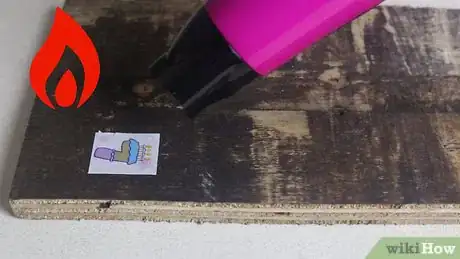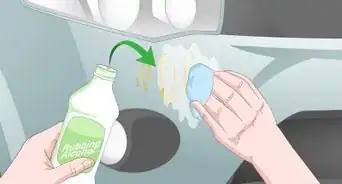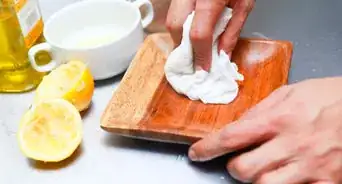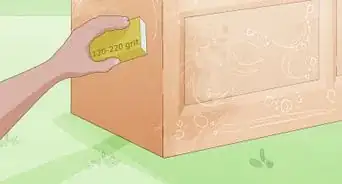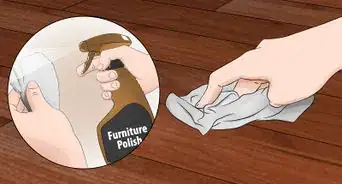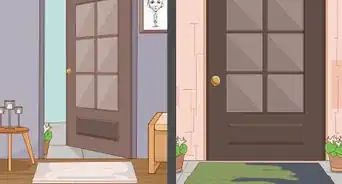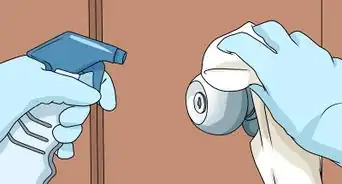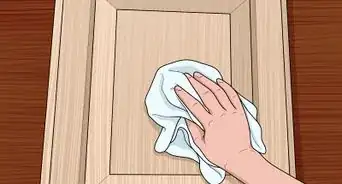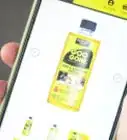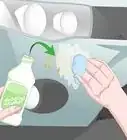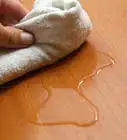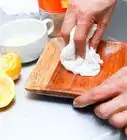This article was co-authored by Raymond Chiu. Raymond Chiu is the Director of Operations for MaidSailors.com, a residential and commercial cleaning service based in New York City that provides home and office cleaning services at affordable prices. He has a Bachelors in Business Administration and Management from Baruch College.
wikiHow marks an article as reader-approved once it receives enough positive feedback. In this case, 88% of readers who voted found the article helpful, earning it our reader-approved status.
This article has been viewed 310,530 times.
Product labels that come with wood should be relatively easy to remove. If your kid went on a spree with the dinosaur stickers, you might need some elbow grease. Don't be frustrated if your first couple attempts don't work. Different stickers require different approaches, and it's not easy to tell what will work in advance.
Steps
Using Heat
-
1Heat the sticker. Use a blow dryer or heat gun on the lowest setting. Heat the entire sticker for a few seconds, then point it at one corner. Keep heating as you continue to the next step.
- Keep the blow dryer two inches (5 cm) away from the wood, and the heat gun at least 3 inches (7.5 cm) away. Heat for no more than 10–15 seconds.[1] Too much heat can damage the wood finish, or cause the sticker to leave a stain.
-
2Lift with a smooth, flat object. A plastic credit card or scraper is safest for the wood. If the wood isn't valuable or antique, you're probably safe with a putty knife, artist's palette knife, or non-serrated, thin butter knife. Scrape the edge of the sticker gently to lift it, at the corner being heated. If it doesn't work, move on, but keep the tool handy.
- If you are handling a valuable or antique piece of wood, use your fingernail instead.
- If your knives are too thick to get under the card, cut a square of plastic from the middle of a plastic container lid.
Advertisement -
3Pull off with tweezers as you heat. Once you have one edge lifted, grasp it with tweezers or needle-nose pliers. Bend this 180º and gradually pull the sticker. For fragile wood, pull across the wood grain to avoid picking up fibers. Angle the blow dryer as you do this, softening the glue as you go. Do not try to rip the sticker off, or you could end up with a more difficult paper backing stuck to the table.
- Continue on to either section below to remove any glue that's left.
Using Solvents
-
1Clean stickers off with white vinegar. Soak a paper towel or cloth in white vinegar. Lay it over the sticker and let it sit five minutes. Gently peel off the sticker using your fingernail or tweezers.[2]
-
2Use a damp cloth for product labels. Product labels on furniture and toys can usually be dissolved with a damp cloth. However, do not add water to stickers that come on sheets for peeling off and pressing on. These pressure-sensitive stickers can become more firmly attached when exposed to water.
- Don't soak the wood, or you could swell the grain and cause damage.
-
3Use a commercial glue remover. If the cloth doesn't work, try a product such as Goo Gone, Goof Off, 3M General Purpose Adhesive Cleaner, or cleaning products that contain citrus oil. Use just enough to wet the sticker. Give plastic or foil stickers a couple of minutes for the product to soak through, or try to lift the edge and apply an additional drop underneath. Once wet and soft, attempt to peel or scrape it off as before.
- Read the label instruction first to make sure the product is safe for wood.
EXPERT TIPRaymond Chiu is the Director of Operations for MaidSailors.com, a residential and commercial cleaning service based in New York City that provides home and office cleaning services at affordable prices. He has a Bachelors in Business Administration and Management from Baruch College.House Cleaning Professional
 Raymond Chiu
Raymond Chiu
House Cleaning ProfessionalTry using nail polish remover to remove the sticker. Nail polish remover can be surprisingly effective at getting adhesive off wood. Gently dab the sticker with a cotton ball dampened with nail polish remover, but be careful not to get the solvent on the wood itself. Have a clean, dry cloth on hand to wipe away any excess, if necessary. Allow the nail polish remover to sit on the sticker for 3-5 minutes, then use a scraper to lift the adhesive off of the wood. Repeat the process as necessary.
-
4Try petroleum jelly or a vaporizing rub instead. These can take up to eight hours to penetrate and soften the adhesive, so this is only worth doing if it saves you a trip to the store. Once soft, scrape the sticker and goo off. Add a few drops pure, concentrated dish detergent to the remaining residue. Rub it in to make a paste, then wipe off with a paper towel.
-
5Dampen with oil. Alternatively, you can use a vegetable or plant oil (particularly eucalyptus oil) or a low-strength mineral oil such as WD40 or baby oil. Dab a few drops over the sticker, let sit a couple of hours, then attempt to scrape off. Plant and mineral oils can have different effects, so you may wish to try one of each, separately.
- This can darken the color of unfinished wood. This is not harmful for most wood — and may even improve its lifespan — but you may wish to apply oil to the rest of the wood so it matches. Use a product intended for the purpose, not the oil you just used.
-
6Apply powerful solvents cautiously. Consider these chemicals a last resort, as they can potentially damage some wood finishes and paint. Use them only in well-ventilated areas or outdoors, since the fumes are toxic and most are quite flammable. Test the product on a corner of the wood first to make sure it's safe.
- Lighter fluid is usually safe on paint and evaporates quickly from the wood. It can still damage some finishes.
- Paint thinner's probably the next safest bet but will damage many finishes. Make sure to test in a corner first.
- Acetone or acetone-based lacquer thinner will destroy lacquer and plastic-based wood finishes — in other words, most of them.
- Rubbing alcohol is an absolute last resort since it can dissolve through most lacquers and damage the wood underneath.
Removing Sticker Residue
-
1Use something oil-based like lemon oil. It wouldn't scratch but would pick up any stubborn residual stickiness. It's best to use something normally used on wood, so it doesn't have to be washed off with detergent.
-
2Pick up residue with magic tape. The transparent Scotch tape labeled "Magic tape" can remove sticker glue without leaving more behind.[3] Lay it over the glue and rip it off once. If there are no significant results, move on to the next step.
- You can try other types of tape if the wood is not valuable. Do not use duct tape, which may leave its residue on the wood.
-
3Wipe off residue with the solvent you used. If you used a solvent to dissolve the glue, it should work on the remaining stickiness as well. Dampen a cloth with a little more of the same substance. Rub for up to 10 minutes, in gentle circular motions.
- Do not do this if the wood feels rougher or looks discolored due to the solvent.
-
4Scrub the wood with soapy water. Mild dishwashing detergent and water may remove small amounts of residue. Use just a drop or two of detergent in a small cup of water. Dampen a cloth or sponge and scrub.
-
5Sand off the wood if nothing else works. If the sticker or sticker residue will not come off, sand through it. Rub with 80 grit sandpaper until the sticker and residue is gone, replacing the paper whenever it gets clogged. Restore the smooth surface with 120-grit sandpaper, then 220-grit.[4]
- Once sanded, reapply whichever finish or paint was used on your wood. If you do not know which finish was used, you may need to sand off the entire surface and apply a new coat from scratch.
Community Q&A
-
QuestionI had pasted some images from magazines on the door of my wooden drawer, using white school glue. How can I remove them?
 Megan16Community AnswerWhite glue is usually water-soluble, so just dampen it, scratch it off and use a wet rag to wipe away the remains.
Megan16Community AnswerWhite glue is usually water-soluble, so just dampen it, scratch it off and use a wet rag to wipe away the remains. -
QuestionMy headboard on my bed has stickers and residue on it, would these steps still work?
 Community AnswerThey should! Give each method a try, but be careful as you go to avoid damaging the wood any further.
Community AnswerThey should! Give each method a try, but be careful as you go to avoid damaging the wood any further. -
QuestionBut what if you do the sandpaper and it scratches the wood?
 Community AnswerUse a fine grit sandpaper and sand lightly to avoid ugly scratches.
Community AnswerUse a fine grit sandpaper and sand lightly to avoid ugly scratches.
Warnings
- Do not smoke or use other heat sources near flammable solvents.⧼thumbs_response⧽
References
- ↑ http://homeguides.sfgate.com/remove-stickers-wood-35140.html
- ↑ http://www.huffingtonpost.com/2012/03/23/spring-cleaning-remove-stickers-furniture_n_1373862.html
- ↑ http://surfrockmusic.com/sticker-shock-how-to-remove-stickers-from-guitars.html
- ↑ http://www.familyhandyman.com/woodworking/how-to-sand-woodwork-by-hand/view-all
About This Article
To get stickers off wood, use a blowdryer to heat the sticker for 10-15 seconds, alternating between heating the center and the corners. Then, use a credit card or a butter knife to lift the edge of the sticker, and use a pair of tweezers to pull the rest of the sticker away from the wood. Work slowly and continue heating the sticker as you pull it up. Don’t try to pull the sticker off quickly, as some of the backing might stay on the wood and will be more difficult to remove. For tips on how to remove any residue leftover from the sticker, keep reading the article!
